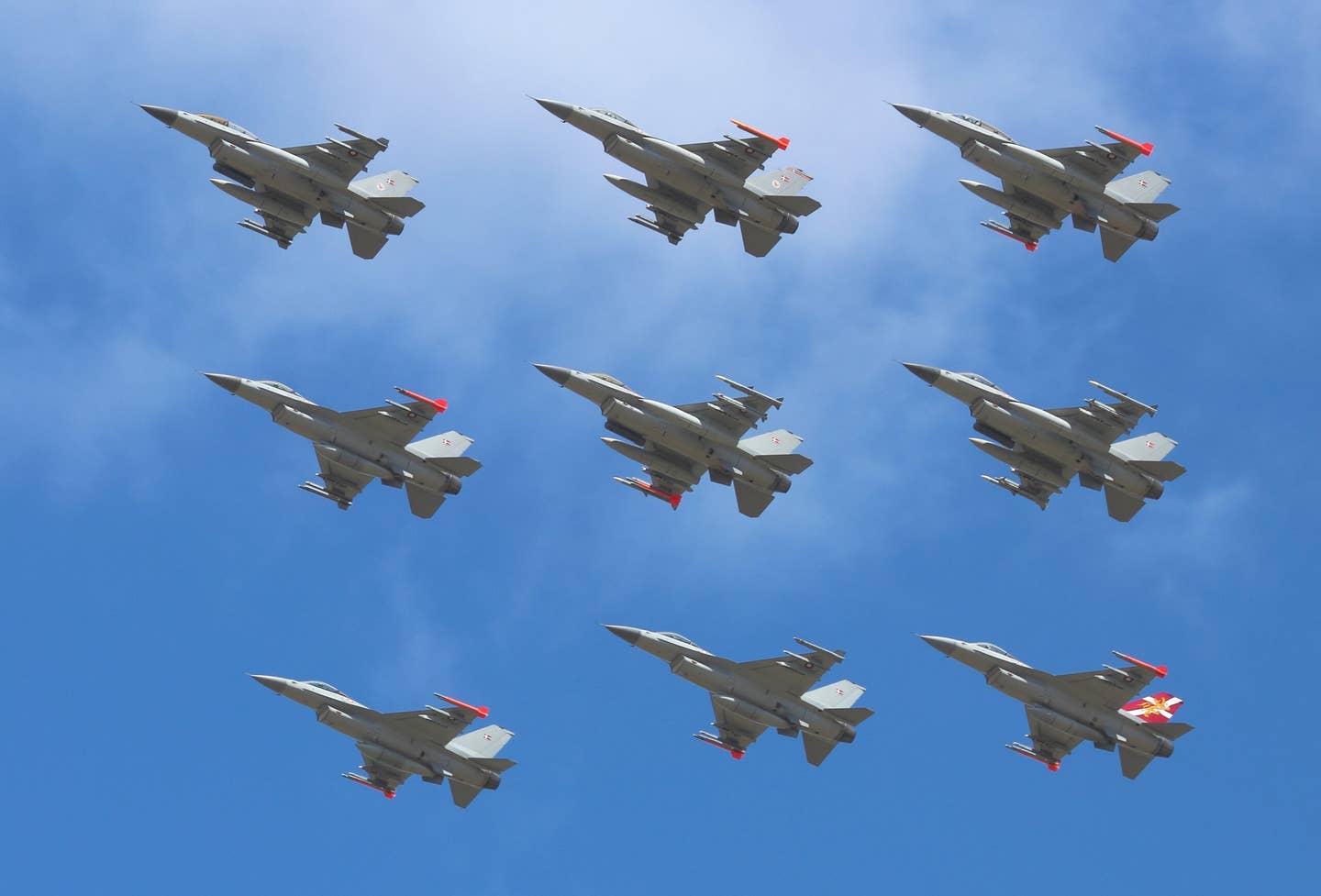A spectacular video has surfaced of nine F-16 Vipers overflying a base at a low level from multiple directions in multi-vector attack drills. In an age of precision-guided weapons, it is rare to see numerous jets attacking an airfield from multiple directions while flying low.
The footage in question is associated with the 40th anniversary of the F-16’s service career in Denmark. The first F-16 for Denmark was delivered on January 28, 1980.
To celebrate this milestone, the Royal Danish Air Force (RDAF) organized two formation flights, one in the morning and another in the afternoon, on January 17, 2020.
The flights entailed complex routes over much of Denmark, including various airbases, airports, and landmarks, with the jets mainly flying at an altitude of around 2,000 feet.
Each formation flight involved ten aircraft, one of which had a camera onboard to record the event.
F-16s in Denmark on an exercise. Lots of aircraft passing through the same airspace quickly. pic.twitter.com/jkEEw1vTxF
— Aviation Ogre (@AvHistoryOgre) January 22, 2023
The video shows a portion of the first formation flight, which concluded at Skrydstrup Air Base in the south of Jutland. The flight ended with a nine-ship flyby, after which a 10-minute ‘squadron attack’ was carried on the base itself.
The same finale was also repeated at the end of the second formation flight in the afternoon.
Low-Flying Multi-Vector Attacks No More Relevant?
During the Cold War, relying on this sort of multi-axis, low-level strike for attacks against airbases was a common tactic.
Flying low serves the purpose of avoiding detection from enemy radars, as observed in the ongoing war in Ukraine. Also, weapons used at the time were designed for low-level releases.

In the era of modern air combat, a multi-vector attack involving several low-flying aircraft is considered unlikely by Western military commentators, as the emergence of precision-guided air-to-surface weapons with varying degrees of stand-off capability has negated the need for fighter pilots to conduct risky ‘point-blank’ raid on an active airbase or any other well-defended target.
However, as EurAsian Times discussed earlier, the severe depletion of inventory of precision-guided munitions had prompted the Russian military to rely heavily on unguided weapons in Ukraine, and as a result of which, Russia’s advanced combat aircraft, like Su-35 and Su-34, were being employed in old fashioned seek-and-destroy missions, which involve the aircraft flying low and visually acquiring the target to attack it.
At the same time, Ukraine’s Western partners are also in trouble, as the war in Ukraine is already eating into their weapons inventory, so much so that NATO member countries are worried that their stockpiles will reach levels below the threshold necessary to fulfill their defense obligations under the North Atlantic Treaty.
An all-out conventional war can potentially cause severe depletion of precision-guided weaponry. Therefore, training to attack a fixed ground target as part of a multi-ship formation like the one staged by RDAF in January 2020 can undoubtedly prove useful for fighter pilots.
The speed and complexity of maneuvers involved in a flight such as that conducted by Danish F-16s over Skrydstrup can help pilots hone their skills in getting to the assigned target or release point on time and at an appropriate altitude.
Nevertheless, such exotic formation flights may soon become extinct, at least in the case of RDAF, which is preparing to retire its F-16s as it works to welcome the new fifth-generation F-35A stealth jets purchased from the US in 2016.
The first two of the planned 27 F-35A Stealth jets for Denmark arrived at Luke Air Force Base, Arizona, in April 2021, where six Danish F-35s are embedded in the 308th Fighter Squadron, a joint US Air Force (USAF), Royal Netherlands Air Force (RNAF), and RDAF training unit.
Until the F-35 takes over the RDAF’s fighter assignment, Skrydstrup’s final squadron of F-16s, 30 of which are operational at any time, will continue to defend Denmark’s airspace, and perform foreign missions as well, which in recent years have involved deployments to Iceland and the Baltic States.
The first batch of RDAF F-35 pilots, who have converted from the F-16, is expected to graduate from the Joint Strike Fighter training syllabus this year, and the first F-35s to be deployed in Denmark is slated to arrive at Skrydstrup this year.
The airbase is undergoing a significant overhaul, with new aircraft shelters, maintenance facilities, and training facilities to host the F-35s.
- Contact the author at tanmaykadam700@gmail.com
- Follow EurAsian Times on Google News